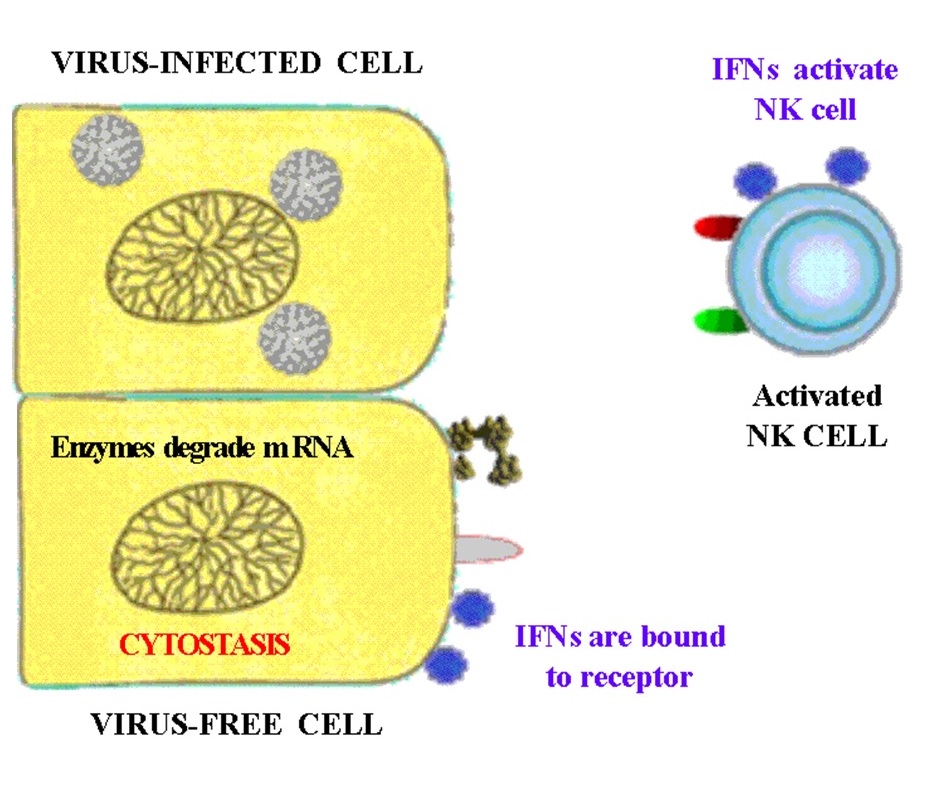
NATURAL CYTOSTASISInterferons |
Interferons (IFNs) are cytokines, which are secreted by a variety of cell types under
the influence of some inducers such as viral envelope glycoproteins, CpG DNA, dsRNA and other Pathogen-Associated
Molecules Patterns (PAMPs) as well as Tumor-Associated Molecular Patterns (TAMPs).
Type I interferons, IFN-α and IFN-β,
are produced by many cell types including lymphocytes (NK cells, B cells, and T cells), macrophages, dendritic cells,
fibroblasts, endothelial cells, osteoblasts and others, and exhibit powerful antiviral and antitumor effects.
They also stimulate NK cells to elicit an antiviral and antitumor response. Besides, IFN-α acts as a pyrogenic
and painful factor by affecting thermosensitive neurons in the hypothalamus that causes fever and pain.
On the other hand, IFN-α interacts with the μ-opioid receptor to act as an analgesic. To affect a target cell,
IFN-α and IFN-β use the CD118 molecule as the receptor.
To date, several effector pathways of the IFN-mediated antiviral response have been described. IFN-inducible enzymes
inside a cell infected by a virus individually block viral transcription, degrade viral RNA, inhibit translation,
and control all steps of viral replication. As a result, natural cytostasis
– Protein Kinase R (PKR);
Among such cytokines as IL-2, IL-12, IL-15, IL-18, and CCL5 (RANTES), IFNs are also powerful activators of NK cells.
©V.V.Klimov
|
 Protein Kinase R (PKR), an RNA dependent protein kinase, inhibits the translation of viral proteins through
phosphorylation of protein synthesis initiation factor eIF-2α. 2',5'-oligoadenylate-synthetase (OAS) mediates
RNA degradation. For this process, the 2nd enzyme, ribonuclease L (RNase L), is required, which becomes activated by
binding 2–5A oligonucleotides. In addition, Mx-protein-GTPases appear to target viral nucleocapsids and inhibit
RNA synthesis. The Mx protein alone is sufficient to block the replication of the virus in the absence of any other
IFN-α/IFN-β-inducible enzymes, but the Mx protein is not induced by IFN-α.
Protein Kinase R (PKR), an RNA dependent protein kinase, inhibits the translation of viral proteins through
phosphorylation of protein synthesis initiation factor eIF-2α. 2',5'-oligoadenylate-synthetase (OAS) mediates
RNA degradation. For this process, the 2nd enzyme, ribonuclease L (RNase L), is required, which becomes activated by
binding 2–5A oligonucleotides. In addition, Mx-protein-GTPases appear to target viral nucleocapsids and inhibit
RNA synthesis. The Mx protein alone is sufficient to block the replication of the virus in the absence of any other
IFN-α/IFN-β-inducible enzymes, but the Mx protein is not induced by IFN-α.